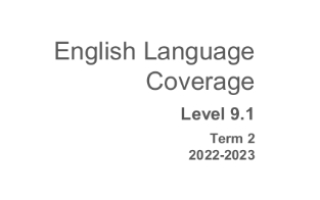بوربوينت قواعد ووظائف نهاية الفصل الثاني اللغة الإنجليزية الصف الثاني عشر
The Coverage, Grammar and Functional Language Teaching Resource
The slides within this resource, although detailed, are designed to be used as a starting point for teachers to construct lessons around the language points that are explored here. The slides are intended to be used individually as a resource within a lesson and to be incorporated as part of instruction incrementally throughout the term to ensure that students have been exposed to all the language points in the mverage ahead of their end of term exam. Therefore. the PowerPoint should not be presented at a single event or in its entirety. Some functional language points may overlap with grammatical points in the coverage, and in that case, it is possible to combine slides. However, this resource should be
considered to be a collection of individual slides that teachers can use to enhance stucknts' learning
Within this document, you will find information about the coverage for this term. The lexis family that assessrnents will contain is mentioned as well as the particular grarnmatical and functional language points that will be tested in the exams at the end of this terrn. In the preparation sections, you will find examples and explanations for the grammatical and functional language points that will be assessed this term
The grammar preparation section has an example sentence that illustrates the grammatical point. It follows this with an explanation of the meaning of the example sentence. Next, the specific grammatical structure used within the example sentence is detailed followed by an explanation of the circumstances under whidl the particular structure is used. More example sentences using the structure are given at the end of the slide. In the functional language preparation section. there are examples of the particular language point followed by an explanation of how the particular are used. In the associated grammar section, language points that comprise the structure or can be used to in conjunction with the language point to express the stipulated function are detailed
When I saw the landscape painting, it was as- if- I- had- trayelled- to- that -hillside
Meaning The nature of the painting made the viewer think they had really travelled to that hillside, even though they hadn't
Grammatical structure as if / though' with the past perfect (equivalent to third conditional)
as if / though + subject + clause in past perfect (had + past participle)
Usage We use 'as if I though' with the past perfect to talk about hypothetical or counterfactual circumstances in the past. The speaker is not actually in the place in the painting, they are just imagining that they are
Other examples She was acting as though she hadn't met me before I felt as if I had broken my arm, but the x-ray showed it was fine One of the houses on my street looked for generations
Leonardo di Vinci was not_only the greatest inventor of his generation, a skilful artist
Meaning Leonardo di Vinci was good at inventing and art. Both these facts are equany important
Grammatical structure Correlative conjunction only
Usage We use the correlative conjunctive structure 'not only' 'but also' to connect two nouns or clauses which hold equal value. In this example. both pieces of information (greatest inventor and skilful artist) are equally important. 'But' and •also' can be split. When •not ony is used at the beginning of a sentence fry emphasis, invert the subject and the verb
Other examples Playing a musical instrument is not onlv a relaxing solo hobby, but also an enjoyable one to do with friends Creating a sculpture is m Lonly tiring it is time consuming will we attend the local Museum Of History and Culture, we'll go to the Dubai Opera House afterwards
Meaning My friend thinks I will like Matisse's art because I like Picasso's art
Grammatical structure Conjunction: subordinating
since + rest of clause
Usage 'Since' can be used in a similar way to 'because' to talk about reasons, causes, and explanations
Other examples We went to the exhibition since we heard it was really interesting
Since I have tried weaving before, I found the sadhu display fascinating
He went to the café since he was ravenously hungry
houses the Mona Lisa, not the Guggenheim! What we need to do is go to Paris if we
Meaning There is an invlCatbn that the painting is in one museum but the speaker emphasizes the correction. The speaker conbnues emphasize that the only way b see the painting is b go to Paris
Grammatical structure Cleft sentences in the past, present and future tense
Usage sentences: It + be + noun + that' who relative clause
Wh- deft sentences: Wh- clause + be + emphasized word / phrase
We use deft sentences to emphasize new information
It-ckft sentences The information that comes after it is etnphasized. We use that to begin the clause that contains informaton that is aready understood
It's the Louvre (emphasized inbrmabon) mat houses the Mona Lisa (informatbn that is already understood) Usually what, but we can also use why, where, how, etc. The information in tle wh- clause is typicaly understood hbrmation, while the information the Wlowing clause is new and emphasized (it is undersbod that need b do sometling) go Paris (this is the new information and is the focus of the deft sentence)
Other examples wasnt until he learnt how to express himsetf effectively that he felt happier she's been wanting to see the am, not that she's seen it Where we'll meet is outskie the restaurant, rather than at the table
Meaning Many think that Dr. Amar has produced sorne inwtant work in the field of science
Grammatical structure Present simple passive to recnrt opinions and subject + is/ are + thought / / considered etc. to + + noun phrase / gerund / passive phrase
Usage This is a formaVacademic to indicate a general or speculation — in other words, there is for discussion atxut what is said When those doing the thinking', etc. are then the. passive form is
The Fauvist movement is believed to a heavy influenæ on the Cubists
Nour is thouqht to be one of the top English students in the country Painting is considered to be more aæessible than sculpture
Ipressed with the quality of art that arrived at the gallery today
Meaning The speaker is not happy with the paintings and drawings that he received
Grammatical structure Inversion with adverbials
adverbial + verb + subject
Usage We use inversion after adverbial phrases to add drama or emphasis. 'l have never seen anything so beautiful' can changed to 'Never before have I seen anything so beautiful' to give further emphasis to the adverb. When adding a adverbial to the of the sentence, the word order also
changes - the subject and the verb swap positions
Never before had I heard such blissful music. It moved me to tears Onlv after waitinq for an hour did my sister finally arrive at my house Under no circumstances would I ever attempt origami I'm no at it




